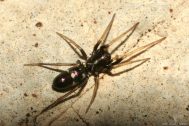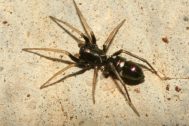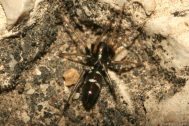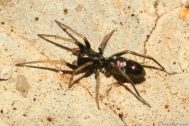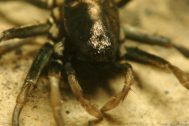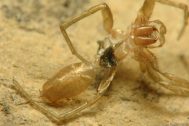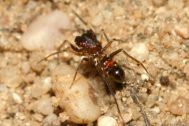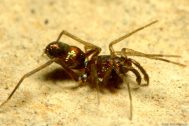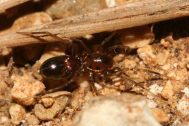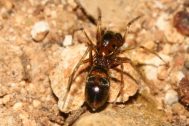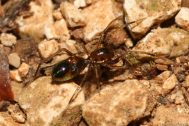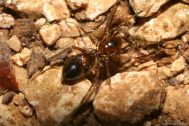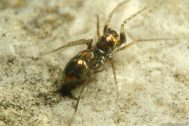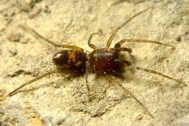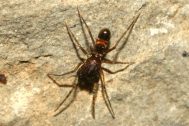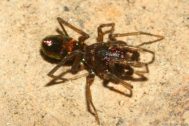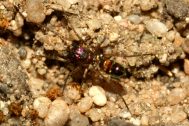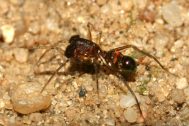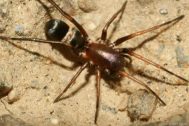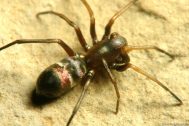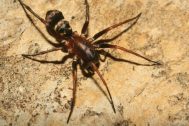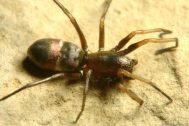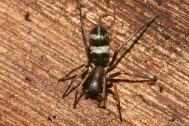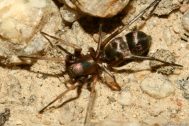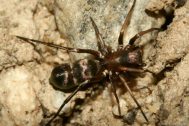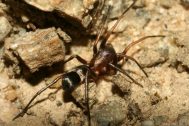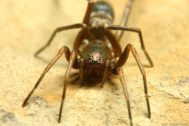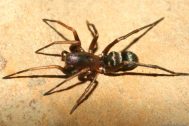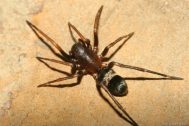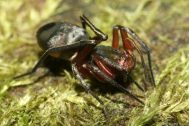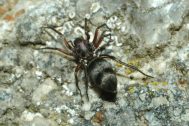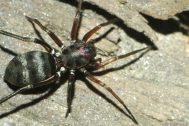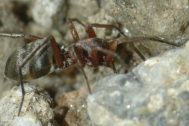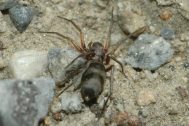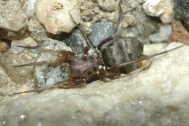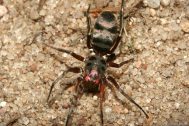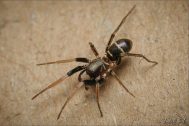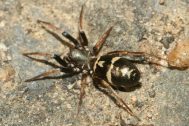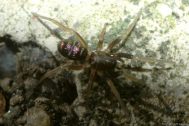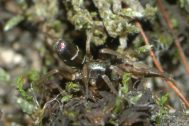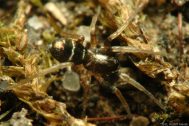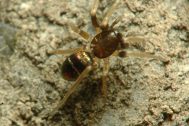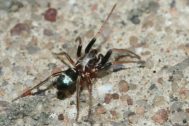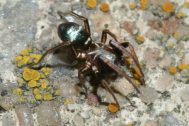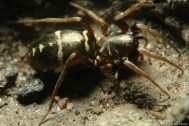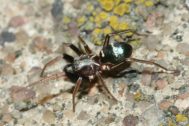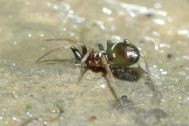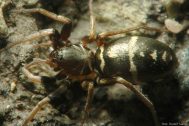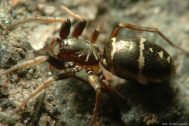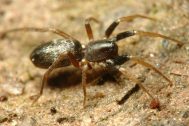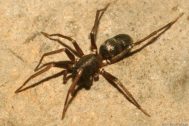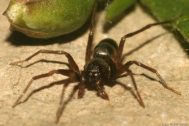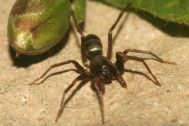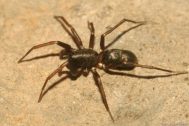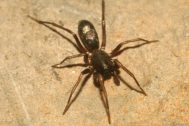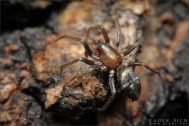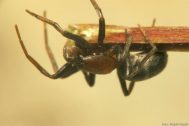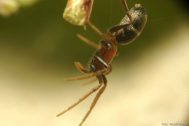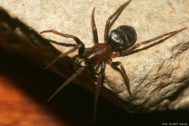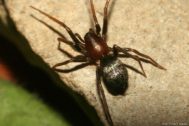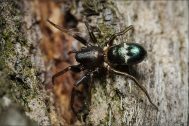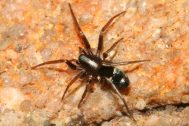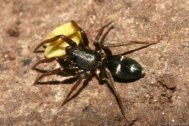| Records by time | |||||
|---|---|---|---|---|---|
| Gnaphosidae | 0-1900 | 1901-1950 | 1951-2000 | 2001+ | ∑ |
 Micaria aenea
Thorell, 1871 Strongly endangered Micaria aenea
Thorell, 1871 Strongly endangered |
5× | 5× | |||
 Micaria albovittata
(Lucas, 1846) Missing Micaria albovittata
(Lucas, 1846) Missing |
3× | 3× | |||
 Micaria dives
(Lucas, 1846) Strongly endangered Micaria dives
(Lucas, 1846) Strongly endangered |
4× | 10× | 20× | 34× | |
 Micaria formicaria
(Sundevall, 1831) Endangered Micaria formicaria
(Sundevall, 1831) Endangered |
1× | 16× | 45× | 62× | |
 Micaria fulgens
(Walckenaer, 1802) Almost threatened Micaria fulgens
(Walckenaer, 1802) Almost threatened |
4× | 5× | 154× | 56× | 219× |
 Micaria guttulata
(C. L. Koch, 1839) Strongly endangered Micaria guttulata
(C. L. Koch, 1839) Strongly endangered |
3× | 10× | 9× | 22× | |
 Micaria lenzi
Bösenberg, 1899 Criticaly endangered Micaria lenzi
Bösenberg, 1899 Criticaly endangered |
2× | 2× | |||
 Micaria micans
(Blackwall, 1858) Not endangered Micaria micans
(Blackwall, 1858) Not endangered |
23× | 23× | |||
 Micaria nivosa
L. Koch, 1866 Endangered Micaria nivosa
L. Koch, 1866 Endangered |
7× | 18× | 25× | ||
 Micaria pulicaria
(Sundevall, 1831) Not endangered Micaria pulicaria
(Sundevall, 1831) Not endangered |
3× | 3× | 261× | 47× | 314× |
 Micaria silesiaca
L. Koch, 1875 Endangered Micaria silesiaca
L. Koch, 1875 Endangered |
1× | 8× | 2× | 11× | |
 Micaria sociabilis
Kulczyński, 1897 Criticaly endangered Micaria sociabilis
Kulczyński, 1897 Criticaly endangered |
1× | 10× | 11× | ||
 Micaria subopaca
Westring, 1861 Endangered Micaria subopaca
Westring, 1861 Endangered |
1× | 1× | 26× | 21× | 49× |
Bibliography
Pavouk 49 (12/2020)
Pavouci České republiky; První nález Cortestina thaleri (Araneae: Oonopidae) v České republice; Theridion hannoniae (Araneae: Theridiidae) v České republice; Křižák vlnkovaný - další nový druh křižáka pro Českou republiku; Vzácní pavouci z exkurze Fluorescenční noci na jižní Moravu; Druhý nález pavučenky po téměř 40 letech; Revize materiálu Micaria pulicaria (Araneae: Gnaphosidae) ve sbírkách Národního muzea v Praze; Inventarizace 2019; Průzkum pavouků PR Mutenská obora; Kolik vajíček nosí slíďák rolní v kokonu v okolí Vyškova?; Hrabalky (Pompilidae) – specialisté na lov pavouků VII: archaické druhy; Stano Pekár letos oslavil 50iny!; Entomologicko-arachnologické exkurze pro veřejnost; Nový výbor a revizní komise České arachnologická společnosti; Česká bibliografie; Britská bibliografie – The Newsletter 148 a 149; Pokyny pro autoryRevize materiálu Micaria pulicaria (Araneae: Gnaphosidae) ve sbírkách Národního muzea v Praze
Based on investigation of historical material, both recently separated species (Micaria micans and Micaria pulicaria) are confirmed in the Czech Republic (see Tab.). The former prefers open, rather lowland habitats, whereas the latter occurs at mountain ranges and/or peat bogs. A useful character for identification of the males turned out to be the position of the terminal curve of the sperm duct in relation to the embolus (see Fig.).Pavouci České republiky
Cortestina thaleri (Knoflach, 2009), Erigone autumnalis Emerton, 1882, Micaria pulicaria (Sundevall, 1831), Neoscona adianta (Walckenaer, 1802) and Theridion hannoniae Denis, 1945 are new records for Czech Republic. Up to 20.12.2020, we included 881 spider species in the araneofauna of the Czech Republic.Ant-mimicking spider actively selects its mimetic model (Araneae: Gnaphosidae; Hymenoptera: Formicidae).
In visual Batesian mimicry, the mimic acquires protection from predators by imitating visual signals of the model. It has not been known whether the occurrence of mimics among models is a result of selection by predators or an active choice by the mimics. Here, the occurrence of an ant-like spider, Micaria sociabilis Kulczyński, 1897, which occurs on tree trunks and visually imitates arboricolous Liometopum microcephalum (Panzer, 1798) ants, was studied. The fauna of arboricolous ant species was surveyed together with six tree characteristics in order to find which variables determined the occurrence and abundance of Micaria sociabilis. It was found that Micaria sociabilis occurred exclusively on trees where L. microcephalum ants occurred. The effect of any tree variable was not significant. The abundance of Micaria sociabilis increased positively with the abundance of L. microcephalum. Then, experiments using an olfactometer and Y-maze with volatile and contact cues obtained from the two most abundant ant species, L. microcephalum and Lasius fuliginosus(Latreille, 1798), were performed to find whether Micaria preferred any cue. Micaria sociabilis did not respond to volatile cues obtained from the gaster of the two ant species. In contrast, it avoided contact cues from L. fuliginosus and was attracted to contact cues from L. microcephalum ants and its gaster extract in hexane. The results thus show that Micaria sociabilis associates exclusively with L. microcephalum and is attracted to contact cues from this ant while avoiding cues from the competing ant. This study reveals that Batesian mimics may use kairomones to associate with visual models.
Výsledky faunistického průzkumu pavouků a sekáčů na vybraných lokalitách na území NM Podyjí v roce 2018
A total of 151 spider species from 27 families and 4 harvestman species from 2 families were found during the zoological research of several sites in Podyjí National Park during 2018. Seventeen of the species found are listed in the Red List of Spiders of the Czech Republic. The most interesting species are Alopecosa sulzeri (Pavesi, 1873), Amaurobius jugorum L. Koch, 1868, Araniella inconspicua (Simon, 1874), Callilepis schuszteri (Herman, 1879), Clubiona marmorata L. Koch, 1866, Echemus angustifrons (Westring, 1861), Gnaphosa lugubris (C. L. Koch, 1839), Gnaphosa opaca Herman, 1879, Gongylidiellum murcidum Simon, 1884, Haplodrassus minor (O. P.-Cambridge, 1879), Kishidaia conspicua (L. Koch, 1866), Micaria formicaria (Sundevall, 1831), Pseudeuophrys obsoleta (Simon, 1868), Saaristoa abnormis (Blackwall, 1841), Tmarus piger(Walckenaer, 1802), Xysticus luctator L. Koch, 1870, Zelotes erebeus (Thorell, 1871) and the harvestmen Egaenus convexus (C. L. Koch, 1835).
Výsledky faunistického průzkumu pavouků a sekáčů na vybraných lokalitách na území NM Podyjí v roce 2018
A total of 151 spider species from 27 families and 4 harvestman species from 2 families were found during the zoological research of several sites in Podyjí National Park during 2018. Seventeen of the species found are listed in the Red List of Spiders of the Czech Republic. The most interesting species are Alopecosa sulzeri (Pavesi, 1873), Amaurobius jugorum L. Koch, 1868, Araniella inconspicua (Simon, 1874), Callilepis schuszteri (Herman, 1879), Clubiona marmorata L. Koch, 1866, Echemus angustifrons (Westring, 1861), Gnaphosa lugubris (C. L. Koch, 1839), Gnaphosa opaca Herman, 1879, Gongylidiellum murcidum Simon, 1884, Haplodrassus minor (O. P.-Cambridge, 1879), Kishidaia conspicua (L. Koch, 1866), Micaria formicaria (Sundevall, 1831), Pseudeuophrys obsoleta (Simon, 1868), Saaristoa abnormis (Blackwall, 1841), Tmarus piger(Walckenaer, 1802), Xysticus luctator L. Koch, 1870, Zelotes erebeus (Thorell, 1871) and the harvestmen Egaenus convexus (C. L. Koch, 1835).
Pavouci vybraných lokalit Mostecka, Chomutovska a Žatecka (severozápadní Čechy).
Arachnologický průzkum na Mostecku a Chomutovsku byl doposud soustředěn zejména na Krušné hory (BUCHAR a HAJER 1999, 2005, 2010. ROUŠAR 2011. RŮŽIČKA a HAJER 2002, 2003), jednotlivé sběry z okolí jsou také zahrnuty v katalogu pavouků ČR (BUCHAR a RŮŽIČKA 2002), na Chomutovsku je známo také několik publikovaných sběrů Antonína Roušara (ROUŠAR 2009, 2015, 2016). Přesto údaje o výskytu pavouků z mnoha lokalit scházejí. Proto od 1. do 4. června 2017 uspořádalo Oblastní muzeum v Mostě arachnologické exkurze do nejbližšího okolí Mostu a Chomutova, kterých se zúčastnili členové České arachnologické společnosti. Jako cílové byly zvoleny lokality, na kterých se systematicky pavoukovci dosud nesbírali, ale i lokality, které by vzhledem ke svým přírodním hodnotám mohly být v budoucnu zařazeny mezi zvláště chráněná území. Tento článek předkládá seznam všech druhů pavouků, kteří byli během akce zjištěni.
Pavouci (Araneae) a střevlíkovití brouci (Coleoptera, Carabidae) vybraných vřesovišť v západních Čechách.
Results of the exploration of the araneofauna and the entomofauna in West Bohemian heathlands are presented. Spiders and carabid beetles were collected during the vegetation seasons in 2011 and 2012 by the method of pitfall trapping. In total, 3188 specimens of 171 Araneae species and 2168 specimens of 93 Carabid species were determined. The most frequent spiders were Xerolycosa nemoralis (Westring, 1861), a common forest species. The following identified species are listed among the endangered spiders in the Czech Republic in the category „endangered“: Alopecosa schmidti (Hahn, 1835), Micaria dives (Lucas, 1846), Peponocranium orbiculatum (O. P.-Cambridge, 1882), in the category „vulnerable“: Centromerus incilium (L. Koch, 1881), Evansia merens O. P.-Cambridge, 1900, Metopobactrus prominulus (O. P.-Cambridge, 1872), Arctosa figurata (Simon, 1876), Arctosa lutetiana (Simon, 1876), Pardosa nigriceps (Thorell, 1872), Gnaphosa bicolor (Hahn, 1833), Xysticus striatipes L. Koch, 1870, Evarcha laetabunda (C. L. Koch, 1846) and Trichopterna cito (Blackwall, 1841). The most remarkable species of the Carabids were the Amara equestris equestris (Duftschmid, 1812), Amara pulpani Kult, 1949, Bradycellus ruficollis (Stephens, 1828), Carabus arcensis arcensis Herbst, 1784, Carabus problematicus harcyniae Sturm, 1815, Cymindis axillaris axillaris (Fabricius, 1794), Cymindis vaporariorum (Linné, 1758), Masoreus wetterhallii wetterhallii (Gyllenhal, 1813), Olisthopus rotundatus rotundatus (Paykull, 1790). Studied material was reposited at the Department of Zoology of the West Bohemian Museum in Pilsen.
Agrární terasy jako refugium xerotermních organismů – příklad z okolí Veverských Knínic.
Hlavním cílem bakalářské práce je zjistit, zda agrární terasy poskytují xerotermním druhům pavouků vhodný biotop a mohou tedy sloužit jako refugium nahrazující přirozené xerotermní biotopy. V rámci komplexu agrárních teras, které slouží k pěstování zemědělských plodin, byly ze šesti existujících svahů vybrány k výzkumu dva. Jako modelová bioindikační skupina byli vybráni pavouci. Odchyt pavouků byl proveden pomocí zemních pastí, které byly rozmístěny ve třech typech porostu a to řídkém, zapojeném a keřovém. Dohromady bylo rozmístěno 18 pastí, které byly umístěny v šesti liniích, kdy každá linie po třech pastech pokrývala jiný typ porostu. Sběr pavouků proběhl celkově osmkrát ve dnech: 19.6.2014, 24.7.2014, 29.8.2014, 6.10.2014, 20.11.2014, 3.6.2015 a 29.6.2015. Celkem bylo odchyceno 635 kusů pavouků patřících do 66 druhů, 44 rodů a 16 čeledí. Dohromady bylo nalezeno 40 xerotermních často i vzácných druhů pavouků. Mezi ohrožené, které patří do Červeného seznamu pavouků České republiky, náleželo pět druhů (VU – 4, EN – 1). Jednalo o Micaria formicaria, Nematogmus sanguinolentus, Neottiura suaveolens a Xysticus striatipes, což jsou druhy vázané na stepi či lesostepi. Nejvýznamnějším nálezem byl Sibianor tantulus, což je teprve třetí záznam tohoto xerotermního druhu pavouka v rámci České republiky. Pomocí jednofaktorové analýzy bylo zjištěno, že druhová diverzita pavouků se v rámci jednotlivých typů porostů a tedy stadií sukcese signifikantně neliší. Pavouci jsou tedy rozšířeni rovnoměrně, a tudíž je třeba zachovat mozaikovitost stanovišť. Výsledky bezesporu vypovídají o ochranářské významnosti agrárních teras jakožto refugia xerotermních organismů.Additional disturbances as a beneficial tool for restoration of post-mining sites: a multi-taxa approach.
Open interior sands represent a highly threatened habitat in Europe. In recent times, their associated organisms have often found secondary refuges outside their natural habitats, mainly in sand pits. We investigated the effects of different restoration approaches, i.e. spontaneous succession without additional disturbances, spontaneous succession with additional disturbances caused by recreational activities, and forestry reclamation, on the diversity and conservation values of spiders, beetles, flies, bees and wasps, orthopterans and vascular plants in a large sand pit in the Czech Republic, Central Europe. Out of 406 species recorded in total, 112 were classified as open sand specialists and 71 as threatened. The sites restored through spontaneous succession with additional disturbances hosted the largest proportion of open sand specialists and threatened species. The forestry reclamations, in contrast, hosted few such species. The sites with spontaneous succession without disturbances represent a transition between these two approaches. While restoration through spontaneous succession favours biodiversity in contrast to forestry reclamation, additional disturbances are necessary to maintain early successional habitats essential for threatened species and open sand specialists. Therefore, recreational activities seem to be an economically efficient restoration tool that will also benefit biodiversity in sand pits.
Female control of mate plugging in a female-cannibalistic spider (Micaria sociabilis)
Background: Sperm competition imposes a strong selective pressure on males, leading to the evolution of various physiological, morphological and behavioral traits. Sperm competition can be prevented by blocking or impeding the access to female genitalia by means of a mating plug. We investigated the factors responsible for plug production and function in the promiscuous female-cannibalistic spider Micaria sociabilis (Gnaphosidae).
Results: We performed mating trials using females with and without a plug that consists of an amorphous mass. The mating trials demonstrated that the probability of male plugging increased non-linearly with the duration of copulation. Copulation duration and plug production seem to be controlled by the female. We found that females terminated matings later if males were fast at genital coupling. Whereas incomplete plugs had disappeared on the day following copulation, complete plugs persisted (40%). In matings with females with complete plugs, only a small proportion of males (7%) were able to remove the plug, indicating the high effectiveness of plugging. Moreover, males ceased attempts to copulate with plugged females with higher probability. 3D X-ray microscopy of the female and male genitalia showed that the plug material can extend far into the female genital tract and that the plug material is produced by a massive gland inside the palpal organ of the modified male pedipalps.
Conclusions: Our study demonstrates that the mating plug in Micaria sociabilis constitutes an effective male strategy to avoid sperm competition that seems to be under female control.
Keywords: Secretory plugs, Sperm competition, Cryptic female choice, Multiple mating, X-ray microscopy
Mate with the young, kill the old: reversed sexual cannibalism and male mate choice in the spider Micaria sociabilis (Araneae: Gnaphosidae).
Gallery
Micaria albovittata
Micaria dives
Micaria formicaria
Micaria fulgens
Micaria micans
Micaria pulicaria
Micaria silesiaca
Micaria sociabilis
Micaria subopaca
Statistics
By month
By altitude
By collecting method (780 used records)
| Zemní past | Males | Females | Juveniles | Records |
|---|---|---|---|---|
| Micaria aenea Thorell, 1871 | 1 | 0 | 0 | 1 |
| Micaria albovittata (Lucas, 1846) | 1 | 0 | 0 | 1 |
| Micaria dives (Lucas, 1846) | 8 | 8 | 0 | 8 |
| Micaria formicaria (Sundevall, 1831) | 12 | 10 | 0 | 17 |
| Micaria fulgens (Walckenaer, 1802) | 153 | 160 | 6 | 140 |
| Micaria guttulata (C. L. Koch, 1839) | 3 | 1 | 0 | 2 |
| Micaria lenzi Bösenberg, 1899 | 3 | 0 | 0 | 2 |
| Micaria micans (Blackwall, 1858) | 14 | 22 | 0 | 17 |
| Micaria nivosa L. Koch, 1866 | 0 | 1 | 70 | 7 |
| Micaria pulicaria (Sundevall, 1831) | 208 | 171 | 6 | 212 |
| Micaria silesiaca L. Koch, 1875 | 5 | 1 | 0 | 6 |
| Micaria subopaca Westring, 1861 | 15 | 4 | 0 | 13 |
| Neurčeno | Males | Females | Juveniles | Records |
| Micaria aenea Thorell, 1871 | 1 | 0 | 0 | 1 |
| Micaria albovittata (Lucas, 1846) | 0 | 4 | 0 | 2 |
| Micaria dives (Lucas, 1846) | 10 | 15 | 1 | 19 |
| Micaria formicaria (Sundevall, 1831) | 19 | 8 | 0 | 27 |
| Micaria fulgens (Walckenaer, 1802) | 15 | 30 | 1 | 52 |
| Micaria guttulata (C. L. Koch, 1839) | 5 | 24 | 4 | 17 |
| Micaria micans (Blackwall, 1858) | 0 | 2 | 0 | 1 |
| Micaria nivosa L. Koch, 1866 | 33 | 19 | 27 | 17 |
| Micaria pulicaria (Sundevall, 1831) | 19 | 14 | 5 | 59 |
| Micaria silesiaca L. Koch, 1875 | 4 | 4 | 1 | 5 |
| Micaria sociabilis Kulczyński, 1897 | 0 | 0 | 0 | 2 |
| Micaria subopaca Westring, 1861 | 8 | 8 | 0 | 18 |
| Individuální sběr | Males | Females | Juveniles | Records |
| Micaria aenea Thorell, 1871 | 0 | 2 | 0 | 2 |
| Micaria dives (Lucas, 1846) | 2 | 4 | 0 | 6 |
| Micaria formicaria (Sundevall, 1831) | 6 | 4 | 2 | 10 |
| Micaria fulgens (Walckenaer, 1802) | 6 | 14 | 1 | 18 |
| Micaria guttulata (C. L. Koch, 1839) | 1 | 1 | 0 | 2 |
| Micaria micans (Blackwall, 1858) | 2 | 1 | 0 | 3 |
| Micaria nivosa L. Koch, 1866 | 0 | 1 | 0 | 1 |
| Micaria pulicaria (Sundevall, 1831) | 14 | 12 | 0 | 20 |
| Micaria sociabilis Kulczyński, 1897 | 3 | 3 | 0 | 5 |
| Micaria subopaca Westring, 1861 | 5 | 11 | 1 | 12 |
| Eklektor | Males | Females | Juveniles | Records |
| Micaria pulicaria (Sundevall, 1831) | 3 | 11 | 3 | 11 |
| Micaria subopaca Westring, 1861 | 2 | 3 | 0 | 4 |
| Prosev | Males | Females | Juveniles | Records |
| Micaria aenea Thorell, 1871 | 1 | 1 | 0 | 1 |
| Micaria dives (Lucas, 1846) | 1 | 0 | 0 | 1 |
| Micaria fulgens (Walckenaer, 1802) | 5 | 3 | 0 | 4 |
| Micaria guttulata (C. L. Koch, 1839) | 1 | 0 | 0 | 1 |
| Micaria micans (Blackwall, 1858) | 1 | 1 | 0 | 2 |
| Micaria pulicaria (Sundevall, 1831) | 4 | 0 | 0 | 4 |
| Smyk | Males | Females | Juveniles | Records |
| Micaria formicaria (Sundevall, 1831) | 7 | 0 | 4 | 2 |
| Micaria fulgens (Walckenaer, 1802) | 3 | 2 | 2 | 2 |
| Micaria pulicaria (Sundevall, 1831) | 0 | 4 | 0 | 4 |
| Žlutá miska | Males | Females | Juveniles | Records |
| Micaria formicaria (Sundevall, 1831) | 1 | 4 | 0 | 5 |
| Micaria pulicaria (Sundevall, 1831) | 0 | 1 | 0 | 1 |
| Pozorování | Males | Females | Juveniles | Records |
| Micaria sociabilis Kulczyński, 1897 | 0 | 0 | 0 | 4 |
| Sklepávání | Males | Females | Juveniles | Records |
| Micaria fulgens (Walckenaer, 1802) | 0 | 2 | 0 | 2 |
| Micaria pulicaria (Sundevall, 1831) | 5 | 4 | 0 | 1 |
| Micaria subopaca Westring, 1861 | 0 | 1 | 0 | 1 |
| Vysavač | Males | Females | Juveniles | Records |
| Micaria formicaria (Sundevall, 1831) | 1 | 3 | 0 | 1 |
| Micaria pulicaria (Sundevall, 1831) | 2 | 5 | 0 | 2 |
| Fotografie | Males | Females | Juveniles | Records |
| Micaria fulgens (Walckenaer, 1802) | 0 | 0 | 0 | 1 |
| Nárazová past | Males | Females | Juveniles | Records |
| Micaria subopaca Westring, 1861 | 1 | 0 | 0 | 1 |
| Males | Females | Juveniles | Records |
By biotope (780 used records)
| Neurčeno | Males | Females | Juveniles | Records |
|---|---|---|---|---|
| Micaria dives (Lucas, 1846) | 17 | 17 | 1 | 23 |
| Micaria formicaria (Sundevall, 1831) | 30 | 15 | 0 | 41 |
| Micaria fulgens (Walckenaer, 1802) | 53 | 39 | 3 | 73 |
| Micaria guttulata (C. L. Koch, 1839) | 4 | 14 | 4 | 14 |
| Micaria micans (Blackwall, 1858) | 8 | 20 | 0 | 13 |
| Micaria nivosa L. Koch, 1866 | 33 | 20 | 97 | 23 |
| Micaria pulicaria (Sundevall, 1831) | 69 | 61 | 5 | 91 |
| Micaria silesiaca L. Koch, 1875 | 4 | 3 | 1 | 5 |
| Micaria sociabilis Kulczyński, 1897 | 2 | 3 | 0 | 6 |
| Micaria subopaca Westring, 1861 | 7 | 9 | 1 | 20 |
| Suché louky | Males | Females | Juveniles | Records |
| Micaria albovittata (Lucas, 1846) | 0 | 1 | 0 | 1 |
| Micaria dives (Lucas, 1846) | 2 | 6 | 0 | 5 |
| Micaria formicaria (Sundevall, 1831) | 2 | 2 | 1 | 4 |
| Micaria fulgens (Walckenaer, 1802) | 16 | 42 | 3 | 25 |
| Micaria guttulata (C. L. Koch, 1839) | 0 | 7 | 0 | 2 |
| Micaria nivosa L. Koch, 1866 | 0 | 1 | 0 | 1 |
| Micaria pulicaria (Sundevall, 1831) | 3 | 4 | 0 | 8 |
| Micaria subopaca Westring, 1861 | 0 | 1 | 0 | 1 |
| Výsadby jehličnanů | Males | Females | Juveniles | Records |
| Micaria fulgens (Walckenaer, 1802) | 1 | 1 | 0 | 2 |
| Micaria pulicaria (Sundevall, 1831) | 42 | 36 | 5 | 33 |
| Micaria subopaca Westring, 1861 | 1 | 1 | 0 | 2 |
| Xerotermní travinobylinná společenstva | Males | Females | Juveniles | Records |
| Micaria albovittata (Lucas, 1846) | 1 | 3 | 0 | 2 |
| Micaria dives (Lucas, 1846) | 1 | 0 | 0 | 1 |
| Micaria formicaria (Sundevall, 1831) | 10 | 1 | 2 | 6 |
| Micaria fulgens (Walckenaer, 1802) | 13 | 6 | 0 | 13 |
| Micaria guttulata (C. L. Koch, 1839) | 3 | 3 | 0 | 3 |
| Micaria pulicaria (Sundevall, 1831) | 8 | 3 | 0 | 8 |
| Micaria silesiaca L. Koch, 1875 | 3 | 0 | 0 | 3 |
| Micaria subopaca Westring, 1861 | 0 | 1 | 0 | 1 |
| Lesy | Males | Females | Juveniles | Records |
| Micaria fulgens (Walckenaer, 1802) | 1 | 3 | 0 | 3 |
| Micaria pulicaria (Sundevall, 1831) | 22 | 32 | 1 | 32 |
| Lesní okraje | Males | Females | Juveniles | Records |
| Micaria aenea Thorell, 1871 | 1 | 2 | 0 | 2 |
| Micaria formicaria (Sundevall, 1831) | 0 | 0 | 0 | 1 |
| Micaria fulgens (Walckenaer, 1802) | 1 | 7 | 1 | 13 |
| Micaria pulicaria (Sundevall, 1831) | 0 | 1 | 0 | 7 |
| Micaria sociabilis Kulczyński, 1897 | 0 | 0 | 0 | 1 |
| Skalní stepi na vápenci | Males | Females | Juveniles | Records |
| Micaria fulgens (Walckenaer, 1802) | 4 | 25 | 3 | 20 |
| Micaria pulicaria (Sundevall, 1831) | 1 | 2 | 0 | 2 |
| Širokolisté horské nivy | Males | Females | Juveniles | Records |
| Micaria pulicaria (Sundevall, 1831) | 26 | 28 | 0 | 22 |
| Rašeliniště | Males | Females | Juveniles | Records |
| Micaria aenea Thorell, 1871 | 2 | 1 | 0 | 3 |
| Micaria pulicaria (Sundevall, 1831) | 8 | 8 | 0 | 15 |
| Micaria silesiaca L. Koch, 1875 | 2 | 1 | 0 | 2 |
| Micaria subopaca Westring, 1861 | 0 | 1 | 0 | 1 |
| Lesostepní doubravy | Males | Females | Juveniles | Records |
| Micaria fulgens (Walckenaer, 1802) | 19 | 48 | 0 | 13 |
| Micaria pulicaria (Sundevall, 1831) | 7 | 0 | 0 | 6 |
| Mokré louky | Males | Females | Juveniles | Records |
| Micaria fulgens (Walckenaer, 1802) | 1 | 0 | 0 | 1 |
| Micaria pulicaria (Sundevall, 1831) | 5 | 2 | 0 | 10 |
| Micaria subopaca Westring, 1861 | 2 | 1 | 0 | 3 |
| Suché doubravy | Males | Females | Juveniles | Records |
| Micaria fulgens (Walckenaer, 1802) | 4 | 6 | 0 | 9 |
| Micaria micans (Blackwall, 1858) | 1 | 1 | 0 | 1 |
| Micaria pulicaria (Sundevall, 1831) | 1 | 0 | 0 | 1 |
| Micaria subopaca Westring, 1861 | 2 | 0 | 0 | 3 |
| Ruderály | Males | Females | Juveniles | Records |
| Micaria formicaria (Sundevall, 1831) | 0 | 1 | 0 | 1 |
| Micaria micans (Blackwall, 1858) | 2 | 0 | 0 | 1 |
| Micaria pulicaria (Sundevall, 1831) | 4 | 3 | 0 | 7 |
| Micaria subopaca Westring, 1861 | 2 | 1 | 0 | 2 |
| Paseky | Males | Females | Juveniles | Records |
| Micaria formicaria (Sundevall, 1831) | 0 | 3 | 0 | 1 |
| Micaria pulicaria (Sundevall, 1831) | 10 | 6 | 0 | 10 |
| Kamenolomy | Males | Females | Juveniles | Records |
| Micaria formicaria (Sundevall, 1831) | 1 | 0 | 0 | 1 |
| Micaria fulgens (Walckenaer, 1802) | 4 | 6 | 0 | 5 |
| Micaria pulicaria (Sundevall, 1831) | 3 | 1 | 0 | 4 |
| Reliktní bory na skalách | Males | Females | Juveniles | Records |
| Micaria formicaria (Sundevall, 1831) | 1 | 1 | 2 | 2 |
| Micaria fulgens (Walckenaer, 1802) | 5 | 7 | 0 | 7 |
| Suché křoviny | Males | Females | Juveniles | Records |
| Micaria formicaria (Sundevall, 1831) | 0 | 1 | 0 | 1 |
| Micaria fulgens (Walckenaer, 1802) | 12 | 1 | 0 | 6 |
| Micaria nivosa L. Koch, 1866 | 0 | 0 | 0 | 1 |
| Micaria subopaca Westring, 1861 | 1 | 1 | 0 | 1 |
| Porosty borůvek | Males | Females | Juveniles | Records |
| Micaria dives (Lucas, 1846) | 1 | 0 | 0 | 1 |
| Micaria fulgens (Walckenaer, 1802) | 11 | 2 | 0 | 4 |
| Micaria pulicaria (Sundevall, 1831) | 5 | 2 | 0 | 3 |
| Lužní lesy nížin | Males | Females | Juveniles | Records |
| Micaria micans (Blackwall, 1858) | 0 | 1 | 0 | 1 |
| Micaria pulicaria (Sundevall, 1831) | 2 | 0 | 0 | 2 |
| Micaria subopaca Westring, 1861 | 4 | 4 | 0 | 5 |
| Ovocné sady s luční vegetací | Males | Females | Juveniles | Records |
| Micaria pulicaria (Sundevall, 1831) | 7 | 0 | 1 | 6 |
| Micaria subopaca Westring, 1861 | 0 | 1 | 0 | 1 |
| Zahradnicky utvářené zahrady a parky | Males | Females | Juveniles | Records |
| Micaria sociabilis Kulczyński, 1897 | 1 | 0 | 0 | 4 |
| Micaria subopaca Westring, 1861 | 3 | 1 | 0 | 3 |
| Pastviny | Males | Females | Juveniles | Records |
| Micaria formicaria (Sundevall, 1831) | 0 | 2 | 0 | 1 |
| Micaria pulicaria (Sundevall, 1831) | 1 | 3 | 0 | 3 |
| Micaria subopaca Westring, 1861 | 8 | 0 | 0 | 2 |
| Písčiny | Males | Females | Juveniles | Records |
| Micaria dives (Lucas, 1846) | 0 | 3 | 0 | 3 |
| Micaria fulgens (Walckenaer, 1802) | 0 | 1 | 0 | 1 |
| Micaria lenzi Bösenberg, 1899 | 2 | 0 | 0 | 1 |
| Micaria silesiaca L. Koch, 1875 | 0 | 1 | 0 | 1 |
| Dubohabřiny | Males | Females | Juveniles | Records |
| Micaria pulicaria (Sundevall, 1831) | 3 | 3 | 0 | 5 |
| Micaria subopaca Westring, 1861 | 0 | 2 | 0 | 1 |
| Rákosiny a orobincové porosty stojatých vod | Males | Females | Juveniles | Records |
| Micaria micans (Blackwall, 1858) | 2 | 0 | 0 | 2 |
| Micaria pulicaria (Sundevall, 1831) | 0 | 3 | 1 | 3 |
| Bučiny nižších poloh | Males | Females | Juveniles | Records |
| Micaria fulgens (Walckenaer, 1802) | 1 | 1 | 0 | 2 |
| Micaria pulicaria (Sundevall, 1831) | 1 | 1 | 0 | 2 |
| Micaria subopaca Westring, 1861 | 0 | 1 | 0 | 1 |
| Těžebny písku a jiných nezpevněných hornin | Males | Females | Juveniles | Records |
| Micaria dives (Lucas, 1846) | 0 | 1 | 0 | 1 |
| Micaria formicaria (Sundevall, 1831) | 2 | 0 | 1 | 1 |
| Micaria fulgens (Walckenaer, 1802) | 1 | 1 | 0 | 2 |
| Micaria guttulata (C. L. Koch, 1839) | 0 | 1 | 0 | 1 |
| Acidofilní bory | Males | Females | Juveniles | Records |
| Micaria fulgens (Walckenaer, 1802) | 22 | 5 | 0 | 4 |
| Micaria pulicaria (Sundevall, 1831) | 1 | 0 | 0 | 1 |
| Luční ostřicové mokřady | Males | Females | Juveniles | Records |
| Micaria pulicaria (Sundevall, 1831) | 0 | 4 | 0 | 4 |
| Ostatní pole | Males | Females | Juveniles | Records |
| Micaria fulgens (Walckenaer, 1802) | 0 | 0 | 0 | 1 |
| Micaria micans (Blackwall, 1858) | 1 | 2 | 0 | 1 |
| Micaria pulicaria (Sundevall, 1831) | 0 | 2 | 0 | 2 |
| Haldy a výsypky | Males | Females | Juveniles | Records |
| Micaria fulgens (Walckenaer, 1802) | 0 | 1 | 0 | 1 |
| Micaria pulicaria (Sundevall, 1831) | 1 | 0 | 0 | 3 |
| Kamenité suti nižších poloh | Males | Females | Juveniles | Records |
| Micaria pulicaria (Sundevall, 1831) | 3 | 2 | 0 | 4 |
| Močály | Males | Females | Juveniles | Records |
| Micaria lenzi Bösenberg, 1899 | 1 | 0 | 0 | 1 |
| Micaria pulicaria (Sundevall, 1831) | 1 | 3 | 1 | 2 |
| Úhory | Males | Females | Juveniles | Records |
| Micaria formicaria (Sundevall, 1831) | 0 | 1 | 0 | 1 |
| Micaria pulicaria (Sundevall, 1831) | 2 | 0 | 0 | 2 |
| Přirozené lesy | Males | Females | Juveniles | Records |
| Micaria fulgens (Walckenaer, 1802) | 1 | 1 | 0 | 2 |
| Micaria pulicaria (Sundevall, 1831) | 1 | 0 | 0 | 1 |
| Louky | Males | Females | Juveniles | Records |
| Micaria fulgens (Walckenaer, 1802) | 1 | 0 | 0 | 1 |
| Micaria pulicaria (Sundevall, 1831) | 2 | 1 | 0 | 2 |
| Stinné skály nižších poloh | Males | Females | Juveniles | Records |
| Micaria fulgens (Walckenaer, 1802) | 6 | 2 | 0 | 1 |
| Micaria pulicaria (Sundevall, 1831) | 0 | 2 | 0 | 2 |
| Mezofilní louky | Males | Females | Juveniles | Records |
| Micaria micans (Blackwall, 1858) | 2 | 0 | 0 | 1 |
| Micaria pulicaria (Sundevall, 1831) | 6 | 0 | 0 | 2 |
| Bylinné porosty břehů | Males | Females | Juveniles | Records |
| Micaria fulgens (Walckenaer, 1802) | 0 | 1 | 0 | 1 |
| Micaria pulicaria (Sundevall, 1831) | 1 | 0 | 0 | 1 |
| Výsadby listnáčů | Males | Females | Juveniles | Records |
| Micaria fulgens (Walckenaer, 1802) | 0 | 1 | 0 | 1 |
| Micaria pulicaria (Sundevall, 1831) | 5 | 4 | 0 | 1 |
| Suché lesní lemy | Males | Females | Juveniles | Records |
| Micaria fulgens (Walckenaer, 1802) | 0 | 2 | 0 | 2 |
| Suťové a roklinové lesy | Males | Females | Juveniles | Records |
| Micaria fulgens (Walckenaer, 1802) | 3 | 0 | 0 | 1 |
| Micaria subopaca Westring, 1861 | 1 | 1 | 0 | 1 |
| Slaniska | Males | Females | Juveniles | Records |
| Micaria micans (Blackwall, 1858) | 1 | 0 | 0 | 1 |
| Micaria pulicaria (Sundevall, 1831) | 0 | 2 | 0 | 1 |
| Vřesoviště nižších poloh | Males | Females | Juveniles | Records |
| Micaria guttulata (C. L. Koch, 1839) | 3 | 1 | 0 | 2 |
| Ostřicové porosty stojatých vod | Males | Females | Juveniles | Records |
| Micaria micans (Blackwall, 1858) | 0 | 1 | 0 | 1 |
| Micaria pulicaria (Sundevall, 1831) | 1 | 0 | 0 | 1 |
| Travnaté stepi | Males | Females | Juveniles | Records |
| Micaria fulgens (Walckenaer, 1802) | 1 | 1 | 0 | 2 |
| Ovocné sady a vinohrady | Males | Females | Juveniles | Records |
| Micaria pulicaria (Sundevall, 1831) | 0 | 1 | 0 | 1 |
| Louky a pastviny | Males | Females | Juveniles | Records |
| Micaria fulgens (Walckenaer, 1802) | 0 | 1 | 0 | 1 |
| Skály a sutě v horách | Males | Females | Juveniles | Records |
| Micaria pulicaria (Sundevall, 1831) | 1 | 0 | 0 | 1 |
| Rašelinné bory | Males | Females | Juveniles | Records |
| Micaria pulicaria (Sundevall, 1831) | 1 | 0 | 0 | 1 |
| Vrbové křoviny - vlhké (vrbové) křoviny | Males | Females | Juveniles | Records |
| Micaria pulicaria (Sundevall, 1831) | 0 | 1 | 0 | 1 |
| Vinice | Males | Females | Juveniles | Records |
| Micaria fulgens (Walckenaer, 1802) | 0 | 0 | 0 | 1 |
| Nízké xerofilní křoviny | Males | Females | Juveniles | Records |
| Micaria formicaria (Sundevall, 1831) | 0 | 2 | 0 | 1 |
| Horské bučiny | Males | Females | Juveniles | Records |
| Micaria fulgens (Walckenaer, 1802) | 1 | 0 | 0 | 1 |
| Břehy tekoucích vod | Males | Females | Juveniles | Records |
| Micaria subopaca Westring, 1861 | 0 | 1 | 0 | 1 |
| Bahnité břehy | Males | Females | Juveniles | Records |
| Micaria micans (Blackwall, 1858) | 0 | 1 | 0 | 1 |
| Lesy vyšších poloh a strmých svahů | Males | Females | Juveniles | Records |
| Micaria pulicaria (Sundevall, 1831) | 1 | 1 | 0 | 1 |
| Males | Females | Juveniles | Records |











